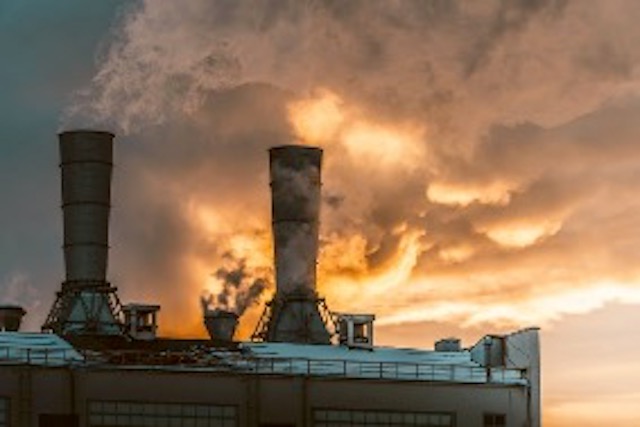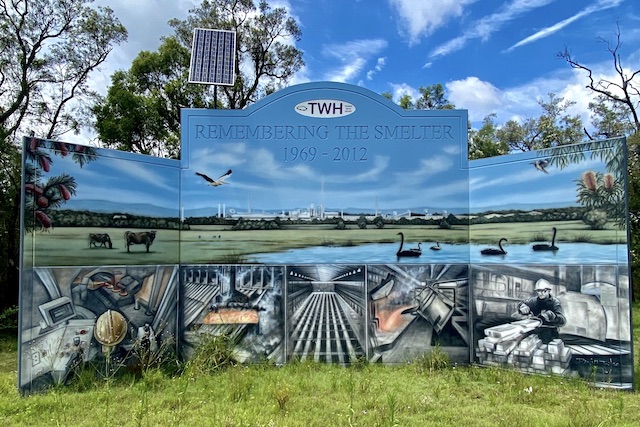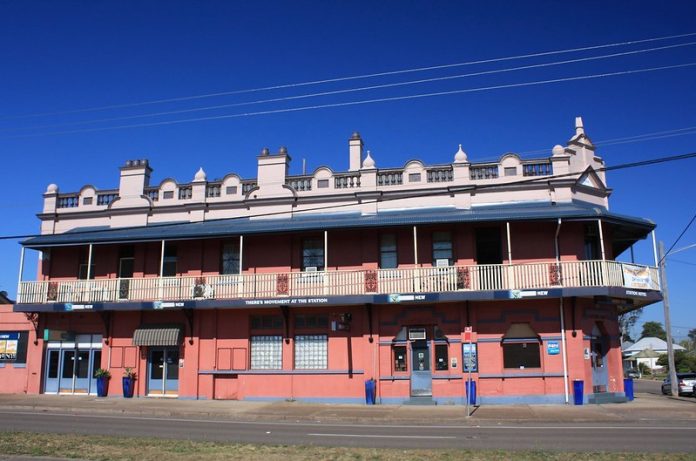I drive into Kurri Kurri northwards from Sydney. It’s a familiar suburban canvas of plain-Jane weatherboard houses and rusty clotheslines. People speak in abbreviations and the streets are named in numbers; First Street, Second Street, Third, all with wide roads, short lawns and shoes dangling from the powerlines. A dinted beer can crunches under my tyres. The township of Kurri Kurri is maybe the closest you will come to quintessential Australiana.
I make my way past my old high school, rolling down my window as red bottlebrush descends from the trees behind the cricket field. A kookaburra sweeps down from the powerlines colouring its wings in the fallout. I take a deep breath and let the scent linger on my tongue. Let it be known, Autumn in Kurri Kurri is marked not by the foliage, but by air redolent of hot-chip grease and corn dogs, and the distinct humming of Elvis Presley hits.
It’s the last weekend of March and residents are sporting leather jackets and their best polka dot frocks for the swinging 60s themed Nostalgia Festival, a yearly affair where the posters of rockabilly icons mask a main street of empty shopfronts.
It’s the town’s best attempt to draw in tourists. As a child it was a blast. I kept my ‘Nostalgia’ skirt at the top of my cupboard. It was blue and pleated all the way to my ankles. I would wave to kids from school and comment on their olden day outfits.
Nostalgia Festival is a novelty, a whacky event to draw in city-slickers to the town, but scratch away at the glitter, you will find mould.
A similar story plays out in summertime when Kurri Kurri hosts the 1980s themed Mullet Fest. The local pub pumps Cold Chisel on the jukebox, and grits its teeth for the sweaty, hairy display of booze and bravado to hail the namesake ’80s hairstyle.
But no 1950s or 1980s facade can completely guise the fact that Kurri Kurri has been suffering from a decade-long economic downturn. The town is desperate for a revival — even if that means making a mockery, getting the mullet chop, line dancing to “Hound Dog” or, as we have seen recently, taking on ScoMo’s plans for a new and nonessential fossil fuel plant.
For Kurri Kurri, being part of the so-called gas fired recovery is less an ecological debate and more a lifeline to pull the town out of crisis.

The town of Kurri Kurri is an old mining settlement in the Hunter Valley. It always has been a hub of industry and blue-collar work rather than the typical chic Hunter Valley weekend getaway. I have always thought of Kurri Kurri as the rogue uncle at the family function, in thongs and sandals, while its surrounding suburbs are in their best dress shoes, too well-mannered to point out the jarring difference.
Perhaps the reason I personify Kurri Kurri as the Aussie Battler incarnate is because in recent years it has copped its fair share of knockabouts. Kurri has been flogged with fires and floods, and most achingly, the loss of its prime industry, the town’s life blood, when the aluminium smelters closed in 2012. The Kurri Kurri population at the time was around 6000 people, and 600 workers were laid off. I remember my grandad held his head in his hands; it was the first time I saw a man cry.
When those jobs went, thousands of locals suffered. As I drive past the main street, more shopfronts are vacant than full, and ‘for lease’ signs are as frequent as the graffiti tags. The desire for blue-collar work in Kurri Kurri is strong. No amount of hot chip grease can veneer the haunting and desolate truth that families are going without, and local business are bearing the fallout.
So, in May this year, when Prime Minister Scott Morrison announced the town would be the new site for a $600 million dollar gas fire power station under Snowy Hydro LTD, Kurri Kurri released the breath it had been holding in for years. Finally, this could be the chance to get the town back on its feet.
But others see the issue differently. While the Nostalgia Festival and Mullet Fest both pay homage to decades past, it is an unkind irony that the hosting township would be the chosen destination for what School Strike for Climate’s Campbell Knox called an “archaic fossil fuel project”.
The Kurri Kurri gas plant is part of PM Morrison’s promise of a “gas fired recovery” to bolster employment, grow business and heave Australia out of the Covid-19-induced economic recession.
Morrison asserts that gas is the most clean, cost-effective energy reserve “when the sun isn’t shining, and the wind isn’t blowing”.
But activists such as Knox warn, “any sort of new fossil fuel project adds to the ever-mounting heating of the globe”.
Knox and I met through a series of online rallies against the Kurri Kurri gas plant held online throughout September. Despite state-mandated lockdowns enforcing social distancing, climate activists in opposition were managing to connect online to educate and inform about the gas plant and its increased carbon emissions on the natural environments of Australia and the world.
“We’re in code red, the last thing we can do is build new gas infrastructure,” said Hunter Free Gas Alliance member, Lynn Benn, in a Zoom session.
And yet, no one online in these digital rallies hailed from Kurri Kurri. I was the only one. I had heard of them not because of my locality, but my metropolitan university newspaper. Many Kurri residents don’t have the time or awareness that these organisations exist to even be looking at the “bigger picture” of the climate crisis Knox describes.
The concerns for those in Kurri Kurri are visible close-up: getting the town back on its feet and back to its hey-day of employment.
So, when Morrison dangles the lure of new industry, promising 600 new jobs in the region, residents of Kurri Kurri see it as the potential salvation the town desperately needs.

As I continue driving around, I spot a big, odd cement structure, roadside just off the expressway. It is a seven-metre-high mural erected in 2019, seven years after the aluminium smelters shut shop. The bottom depicts grey steel, production lines, machinery and working hands coloured with bursts of orange molten aluminium. The top half shows blue skies with the aluminium cylinders proud and tall on the horizon. It reads:
“REMEMBERING THE SMELTER 1969 — 2012”
I follow the road. I come to the wreckage of the old smelter sheds. This, sentimentally, is the spot for the gas fire power station. With Morrison’s 600 jobs promise, both employment and locale will reproduce what was lost in 2012.
But according to Lynn Benn, while the gas plant is touted as employing people, there is a catch in Morrison job promise — 600 marks the peak construction phase. In the long-term, the total number caps at about ten: 600 is the political bait, what she described as “political folly”.
This subterfuge from the Morrison government has been scrutinised, queried and challenged in newspapers across the country, and certainly in these online actions. And yet, for many Kurri Kurri locals, this information has not penetrated public consciousness.
Morrison’s claims of economic revival provide a false sense of economic and community security and are toying with the heartstrings of a town longing for the golden days of its industrial boom.
I pull up the handbrake and step out of my car just off Kurri Kurri’s main street. My kitten heels clip-clop on the pavement and I enter a scene that looks like supercuts from Grease. Children are swirling in their poodle skirts; men puff from cigars and retirees are rotating their hips to do the twist. It’s all fun, but I can’t help wondering if the town of Kurri Kurri is too reliant on its past industrial era and is not being given the resources, funding or economic security to build itself up for the future.


